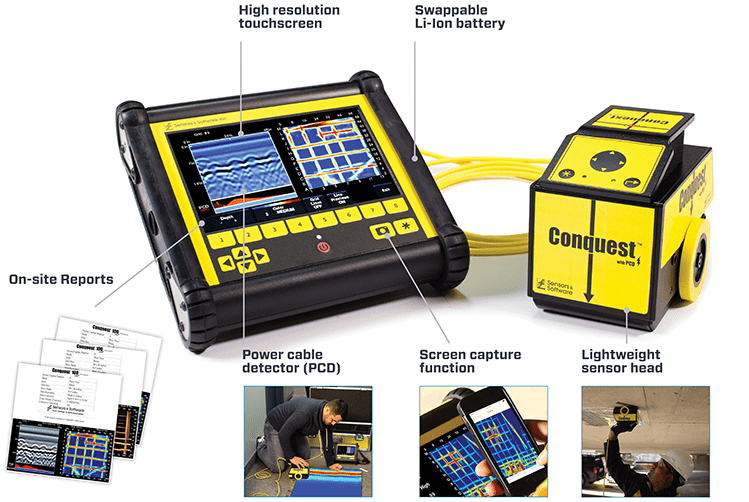Advanced Concrete Scanning Techniques: Making Sure Architectural Honesty
Advanced Concrete Scanning Techniques: Making Sure Architectural Honesty
Blog Article
Reveal the Transformative Power of Concrete Scanning in Making The Most Of Performance and Security
Concrete scanning has actually emerged as a critical tool in the building market, supplying exceptional advantages in boosting task effectiveness and making sure safety criteria. The transformative power of concrete scanning lies in its capacity to give thorough insights and real-time data, revolutionizing how tasks are intended and executed.
Importance of Concrete Scanning
Ensuring the architectural stability and safety of construction tasks begins with the essential step of performing complete concrete scanning. Concrete scanning is a non-destructive technique used to identify and map subsurface aspects within concrete structures. This procedure is vital in determining potential threats, such as rebar, post-tension cords, and channels, that might be concealed within the concrete. By utilizing advanced modern technologies like ground-penetrating radar (GPR) and electro-magnetic induction, construction groups can properly find these aspects without triggering any damage to the framework.
The significance of concrete scanning can not be overemphasized, as it plays a vital function in protecting against accidents, lessening task delays, and making sure the lasting sturdiness of the building and construction. By identifying possible hazards before the building stage starts, home builders can implement suitable precaution and make notified choices concerning the style and execution of the project. Furthermore, concrete scanning aids in enhancing job timelines and spending plan by staying clear of unanticipated costs and delays that may occur because of unanticipated blockages within the concrete. Inevitably, purchasing thorough concrete scanning is a proactive method that enhances both effectiveness and security in building tasks.
How Concrete Scanning Works
Concrete scanning runs as a critical device in building projects by using advanced modern technologies to discover and map subsurface aspects without triggering structural damage. Ground Passing Through Radar (GPR) and Electromagnetic Induction (EMI) are two main techniques utilized in concrete scanning.
Throughout the scanning process, the information collected is examined in real-time, allowing instant recognition of potential dangers or obstacles below the surface area. This information aids in decision-making, ensuring that building tasks continue safely and effectively. In addition, 3D imaging software can be used to develop topographic maps of the subsurface elements, even more enhancing task planning and execution. By using these innovative innovations, concrete scanning substantially reduces the danger of costly problems and injuries on building and construction sites.
Advantages of Concrete Scanning
One of the main benefits of concrete scanning is the capacity to identify and find ingrained things such as rebar, post-tension cable televisions, and avenues properly. Concrete scanning helps in preparation and making extra effectively, as it offers exact info regarding the place and depth of structural components.

Study: Concrete Scanning Success

In one more case, a building firm used 3D concrete scanning to analyze the condition old concrete structures in a historical structure. The detailed scans offered beneficial understandings into the degree of damage and aided prioritize maintenance efforts successfully. By proactively resolving areas of issue determined via scanning, the company was able to prolong the life expectancy of the framework and ensure resident security.
These case studies highlight the transformative power of concrete scanning in boosting efficiency, accuracy, and security in construction jobs.
Carrying Out Concrete Scanning in Projects
Implementing advanced scanning innovations throughout building and construction projects has actually ended up being significantly vital for improving accuracy and safety. By incorporating concrete scanning into project preparation and implementation, construction groups can determine potential dangers, such as rebar or post-tension cables, hidden within concrete structures. This positive technique decreases the threat of accidents, delays, and expensive rework, inevitably leading my link to more efficient job timelines and budget plans.
To execute concrete scanning efficiently, job managers ought to collaborate closely with experienced scanning specialists to establish one of the most appropriate scanning methods for the particular project requirements. Involving scanning professionals from the beginning of a task allows the team to create thorough scanning strategies that attend to essential areas of issue and make sure complete data collection.
Furthermore, integrating concrete scanning right into routine project process can enhance decision-making procedures, as real-time check information offers immediate understandings into the problem of concrete structures - Concrete Scanning. This data-driven strategy assists in educated analytical and makes it possible for teams to make modifications promptly, promoting a society of efficiency and security throughout the task lifecycle

Final Thought
In conclusion, concrete scanning plays an important duty in enhancing effectiveness and safety and security in construction jobs. By making use of advanced technology to identify and map out underlying structures within concrete, this procedure aids to prevent expensive errors, make sure architectural honesty, and minimize risks on site. With the capability to discover surprise elements and provide precise data, concrete scanning confirms to be a valuable More about the author tool for maximizing task outcomes and maximizing overall success.
Concrete scanning is a non-destructive method utilized to detect and map subsurface elements within concrete frameworks. Furthermore, concrete scanning aids in optimizing job timelines and spending plan by staying clear of unforeseen prices and hold-ups that may develop due to unexpected obstructions within the concrete. One notable situation research entails a large-scale restoration task where concrete scanning played a critical role in guaranteeing task success.In an additional case, a building business used 3D concrete scanning to analyze the problem of maturing concrete structures in a historical building. By incorporating concrete scanning right into task planning and execution, building teams can determine potential threats, such as rebar or post-tension cords, hidden within concrete frameworks.
Report this page